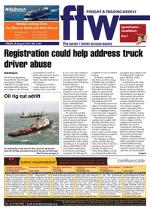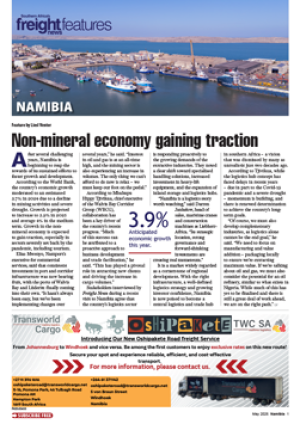Following significant
organisational
restructuring over the past
year or two new Safmarine
CEO David Williams has
been given the mammoth
task of getting all hands
on deck as quickly as
possible to ensure volume
and profitability
targets.
This while
ensuring
customers
have a
positive
experience
in doing
business with
Safmarine and the brand
remains strong.
No easy feat taking
the tough economic
environment and challenges
facing shipping lines
into consideration – be it
overcapacity, weak demand
or even weaker freight rates.
Speaking to FTW during
a recent visit to South Africa
after being in the proverbial
hot seat for only 45 days,
Williams said despite the
challenges he was positive
that Safmarine would be
able to deliver a service
that was distinct and
expected.
“Overall, the industry
continues to be challenged
by overcapacity
which is
reflected
in historically low ocean
freight rates in the east-west
trades, also spilling over
into the north-south trades,”
he said. “The low rates
remain a concern but are
hardly surprising. They are
the consequence of the gap
between supply and weaker
demand.”
Williams will be meeting
with stakeholders and
customers across key markets
but said he was not rushing
into any new strategy –
rather gathering information
around the challenges the
business faces.
“I have dedicated the first
90 days to this after which
we will organise a global
leadership meeting to chart
the way forward,” he said. “At
this stage our cost leadership
strategy
remains
in place to
ride out the
current cycle,
and while it
is challenging
we are also in
a very good
position.”
He said
global
Safmarine
volumes in
the first two
quarters of the year were at
the same level as they had
been the previous year and
expectations of improving
in the latter half of the year
were high.
“Overall I am very satisfied
with the results of the first
half of the year,” he said.
According to Matt Conroy,
trade manager of Safmarine
South Africa, there has been
good growth in the southern
Africa region. “It remains
our largest
cluster and
we are very
focused on
growth in
this region.
The first
half of this
year has seen total import
and export market growth of
7% which is very good when
compared to last year when
we had negative 5% in the
first half of the year.”
But, said Williams, one
cannot ignore the fact that
volumes are only just back to
the 2013 levels. “It is prudent
that we acknowledge that
2014 was a very difficult year
for the southern African
market.”
But, he said, they were
optimistic that African
volumes in the long run
would increase. With
economies continuing to
develop and the growing
consumer market, Williams
said there was recognition
of the good opportunities
that Africa was likely to
present in the long run.
“While it’s a major
challenge on the one hand,
the slowing demand gives
African ports a window
to get infrastructure in
place. We are forecasting
significant
growth in
the long
run for
Africa and
increased
investment
in port
infrastructure is required
to facilitate and service
bigger vessels. Already
it is happening and
developments are occurring
at a rapid pace across the
continent.”
It’s not necessarily
smooth sailing all the way,
with many challenges still
to overcome, but Williams
is confident about the
predicted African growth
that will ultimately
translate into Safmarine
growth and better
profitability.
INSERT
7% Total import and export market growth
duing the first half of this year.
INSERT & CAPTION
The slowing demand
gives African ports
a window to get
infrastructure in
place.
– David Williams
New Saf CEO charts the way forward
28 Aug 2015 - by Liesl Venter
0 Comments
FTW - 28 Aug 15

28 Aug 2015
28 Aug 2015
